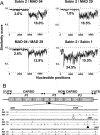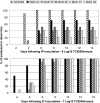Co-circulation and evolution of polioviruses and species C enteroviruses in a district of Madagascar
- PMID: 18085822
- PMCID: PMC2134956
- DOI: 10.1371/journal.ppat.0030191
Co-circulation and evolution of polioviruses and species C enteroviruses in a district of Madagascar
Abstract
Between October 2001 and April 2002, five cases of acute flaccid paralysis (AFP) associated with type 2 vaccine-derived polioviruses (VDPVs) were reported in the southern province of the Republic of Madagascar. To determine viral factors that favor the emergence of these pathogenic VDPVs, we analyzed in detail their genomic and phenotypic characteristics and compared them with co-circulating enteroviruses. These VDPVs appeared to belong to two independent recombinant lineages with sequences from the type 2 strain of the oral poliovaccine (OPV) in the 5'-half of the genome and sequences derived from unidentified species C enteroviruses (HEV-C) in the 3'-half. VDPV strains showed characteristics similar to those of wild neurovirulent viruses including neurovirulence in poliovirus-receptor transgenic mice. We looked for other VDPVs and for circulating enteroviruses in 316 stools collected from healthy children living in the small area where most of the AFP cases occurred. We found vaccine PVs, two VDPVs similar to those found in AFP cases, some echoviruses, and above all, many serotypes of coxsackie A viruses belonging to HEV-C, with substantial genetic diversity. Several coxsackie viruses A17 and A13 carried nucleotide sequences closely related to the 2C and the 3D(pol) coding regions of the VDPVs, respectively. There was also evidence of multiple genetic recombination events among the HEV-C resulting in numerous recombinant genotypes. This indicates that co-circulation of HEV-C and OPV strains is associated with evolution by recombination, resulting in unexpectedly extensive viral diversity in small human populations in some tropical regions. This probably contributed to the emergence of recombinant VDPVs. These findings give further insight into viral ecosystems and the evolutionary processes that shape viral biodiversity.
Conflict of interest statement
Figures




Similar articles
-
Enterovirus detection in different regions of Madagascar reveals a higher abundance of enteroviruses of species C in areas where several outbreaks of vaccine-derived polioviruses occurred.BMC Infect Dis. 2022 Nov 8;22(1):821. doi: 10.1186/s12879-022-07826-0. BMC Infect Dis. 2022. PMID: 36348312 Free PMC article.
-
Common and diverse features of cocirculating type 2 and 3 recombinant vaccine-derived polioviruses isolated from patients with poliomyelitis and healthy children.J Infect Dis. 2012 May 1;205(9):1363-73. doi: 10.1093/infdis/jis204. Epub 2012 Mar 29. J Infect Dis. 2012. PMID: 22457288
-
A Sabin 3-derived poliovirus recombinant contained a sequence homologous with indigenous human enterovirus species C in the viral polymerase coding region.J Virol. 2005 Oct;79(20):12650-7. doi: 10.1128/JVI.79.20.12650-12657.2005. J Virol. 2005. PMID: 16188967 Free PMC article.
-
Recombination between poliovirus and coxsackie A viruses of species C: a model of viral genetic plasticity and emergence.Viruses. 2011 Aug;3(8):1460-84. doi: 10.3390/v3081460. Epub 2011 Aug 17. Viruses. 2011. PMID: 21994791 Free PMC article. Review.
-
Circulating vaccine-derived polioviruses: current state of knowledge.Bull World Health Organ. 2004 Jan;82(1):16-23. Epub 2004 Feb 26. Bull World Health Organ. 2004. PMID: 15106296 Free PMC article. Review.
Cited by
-
Characterization of four vaccine-related polioviruses including two intertypic type 3/type 2 recombinants associated with aseptic encephalitis.Virol J. 2016 Sep 27;13(1):162. doi: 10.1186/s12985-016-0615-2. Virol J. 2016. PMID: 27677968 Free PMC article.
-
Impact of exogenous sequences on the characteristics of an epidemic type 2 recombinant vaccine-derived poliovirus.J Virol. 2008 Sep;82(17):8927-32. doi: 10.1128/JVI.00239-08. Epub 2008 Jun 25. J Virol. 2008. PMID: 18579607 Free PMC article.
-
Complete coding sequence characterization and comparative analysis of the putative novel human rhinovirus (HRV) species C and B.Virol J. 2011 Jan 7;8:5. doi: 10.1186/1743-422X-8-5. Virol J. 2011. PMID: 21214911 Free PMC article.
-
Environmental poliovirus surveillance during oral poliovirus vaccine and inactivated poliovirus vaccine use in Córdoba Province, Argentina.Appl Environ Microbiol. 2009 Mar;75(5):1395-401. doi: 10.1128/AEM.02201-08. Epub 2009 Jan 5. Appl Environ Microbiol. 2009. PMID: 19124585 Free PMC article.
-
Evidence of recombination and genetic diversity in human rhinoviruses in children with acute respiratory infection.PLoS One. 2009 Jul 27;4(7):e6355. doi: 10.1371/journal.pone.0006355. PLoS One. 2009. PMID: 19633719 Free PMC article.
References
-
- Pallansch M, Roos R. Enteroviruses: polioviruses, coxsackieviruses, echoviruses, and newer enteroviruses. In: Knipe D, Howley P, editors. Fields virology. Philadelphia: Lippincott Williams and Wilkins; 2001. pp. 723–775.
-
- Anonymous. Progress toward interruption of wild poliovirus transmission worldwide, January 2006–May 2007. Morb Mortal Wkly Rep. 2007;56:682–685. - PubMed
-
- Minor PD. The molecular biology of poliovaccines. J Gen Virol. 1992;73:3065–3077. - PubMed
-
- Dahourou G, Guillot S, Le Gall O, Crainic R. Genetic recombination in wild-type poliovirus. J Gen Virol. 2002;83:3103–3110. - PubMed
Publication types
MeSH terms
Substances
LinkOut - more resources
Full Text Sources
Other Literature Sources
Research Materials
Miscellaneous

